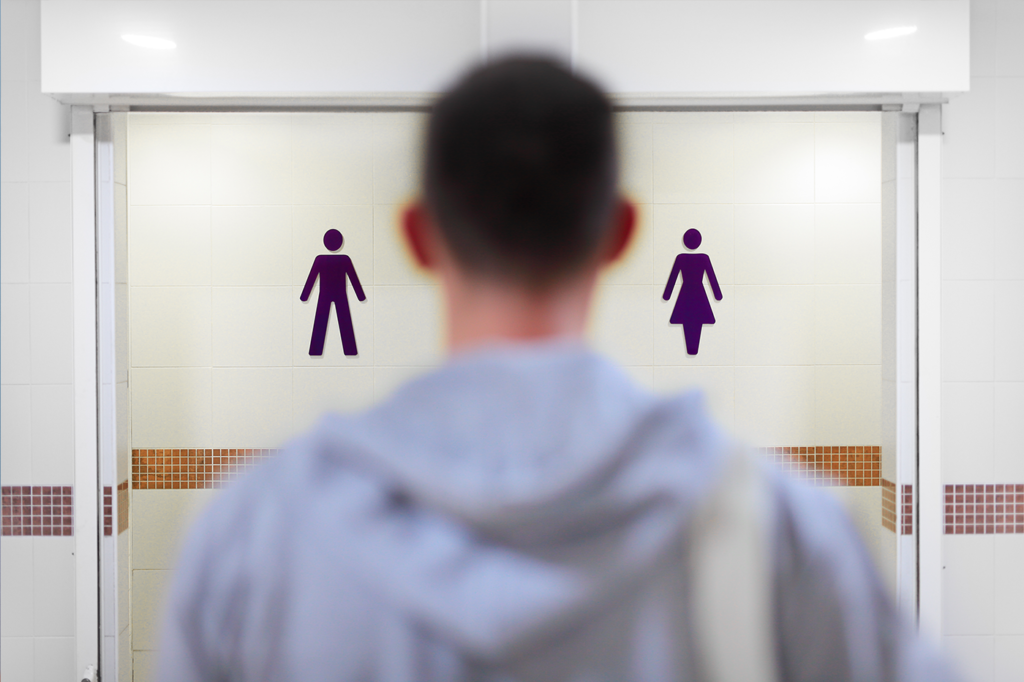Consider the experience of some northern Illinois high-school girls, as one federal court recently described it. In Students and Parents for Privacy v. High School District 211, Judge Jorge Alonso wrote that several of them were “startled, shocked, embarrassed, and frightened by the presence of a male in the girls’ restroom,” most especially when “female student A” was “exposed to this male’s penis.” No wonder: he also found that these students “are at continual risk of encountering (and sometimes do encounter), without their consent, members of the opposite sex while disrobing, showering, urinating, defecating and while changing tampons and feminine napkins.”
The naked guy was no streaker or everyday pervert. He was a student. The school did nothing to discipline him.
The naked guy was no streaker or everyday pervert. He was a student. The school did nothing to discipline him. In fact, the school authorities had sent him there under what they unapologetically called a “compelled affirmation” policy governing transgendered students’ access to intimate school facilities. Judge Alonso dismissed all complaints about the policy that were based on rights protected by the Constitution, including the free exercise of religion, students’ right of bodily privacy, and parents’ right to direct the education of their children. He did, however, permit statutory claims for sexual harassment and violation of the Illinois Religious Freedom Restoration Act to go forward, possibly to trial.
Considerable cultural clout is wielded today by those who say that transgender affirmation of this sort is the next test of whether Americans care about personal authenticity—or a certain tranche of suffering children at all. Courts so far have mostly bought into this profoundly uncaring program, requiring “affirmation” where schools have demurred, and rebuffing students (such as the girls in District 211) who resist it.
Start your day with Public Discourse
Sign up and get our daily essays sent straight to your inbox.The Supreme Court has yet to be heard on the question. It punted a North Carolina “bathroom” case back to lower courts a couple years ago. The Civil Rights Act cases currently pending include one about transgenderism and sex discrimination—but it pertains to adults and employment, not to kids and schools. Whatever the justices decide about that, it will shed only a little, indirect light on what they will eventually decide in a “bathroom” case. Make no mistake about it: in the next two or three years, the high court will be obliged to specify the respective rights of gender-dysphoric students and their “startled” classmates when it comes to sharing bathrooms, showers, and locker rooms. Before the Court does so, it would be good if conservatives amend the arguments they have so far deployed on behalf of “shocked” students. They need to be less modest in their appeals to moral truths about the human person and chastity, for the good reason that the only sound argument in their favor depends essentially on them.
It comes down to a fair question: what is the actual harm to those alarmed girls?
The judge who decided Parents for Privacy v. Dallas School District No. 2 identified the harms as the girls’ lawyer invited him to do. He said that the offended students do not want to “see or be seen by someone of the opposite biological sex while either are [sic] undressing or performing bodily functions in a restroom, shower, or locker room.” True enough. But so far stated, the point is stuck in the emotive sands of what some people happen to want or, more exactly, in some kids’ unwanted feelings. The frightened students assert that they have a right to “be free from government-enforced, unconsented risk of exposure to the opposite sex when they or members of the opposite sex are partially or fully unclothed.” Indeed, they do. But why? What is the compelling ground of this putative right?
Judge Alonso’s description of the girls’ reaction—“startled, shocked, embarrassed, and frightened”—is typical of what the law generally calls “emotional distress.” It is a matter of adverse emotional and psychological experience, of feelings of repugnance. These feelings are not legally inert; in some circumstances, one can successfully plead for damages for the unjustified infliction of emotional distress, usually involving what is by any standard of decorum someone else’s unjustifiably outrageous conduct. Unfortunately, this way of arguing the “bathroom” issue sets up a conflict between the transient feelings of a few teens and the basic well-being, mental health, happiness, and possibly even survival of a potentially suicidal classmate. It is easy to pick the winner when this conflict finds its way into the nation’s courts.
In fact, the girls’ reaction could be described in exactly the same way that Judge Alonso described it if, say, they walked in and saw a female classmate doing something in the common area which really should be done in the privacy of a stall. In that scenario, the girls would understandably be disgusted, and offended, and “shocked.”
They ask: what is the big deal about just one kid—a “Gavin” or an “Ash”—who will quickly go and/or shower and be done with it? But this dodge won’t do.
Courts engulfed by misguided sympathy for gender-dysphoric student sometimes also rely on what they say is the very exceptional nature of transgendered students. They ask: what is the big deal about just one kid—a “Gavin” or an “Ash”—who will quickly go, or shower, and be done with it? But this dodge won’t do. It is true that only individual plaintiffs appear in the lawsuits. But plausible estimates of the number of self-identified transgender students in high schools across the country range anywhere from two to three percent up to nine percent of the total student body. And there is good reason to expect that, as “compelled affirmation” policies and the wider elite-cultural promotion of transgender identity proliferate, so too will the number of confused high-school students. Copy-cat sexual identity questioning is already a documented phenomenon.
More importantly, wherever school officials buy into “affirmation,” every student’s understanding of himself or herself as embodied, as male or female in body and mind, is threatened. Where the school promotes “affirmation,” each student’s self-understanding as an integrated unity is contradicted. If anyone’s true sexual self is trapped in the wrong body, anyone else’s could be. If anyone’s could be, then everyone possesses a gender identity that might be different from his or her natal sex. Everyone is then transported to a world of body-self dualism. Besides, everyone in the path of even just one trans classmate is at serious peril of having to lie about that person’s sex.
I think that the case against compelled affirmation policies needs to be more explicitly and vividly sexualized. By that I mean that the argument against these policies must be rooted in the civil liberties of objecting students, as they pertain to the morality of acts which cause sexual arousal; which instigate impure thoughts; and which threaten both the healthy psycho-sexual development of young people and—most importantly in our cultural moment—the right not to be forced to be the object of another’s sexual gaze—the occasion for the arousal of another person. This improvement synthesizes the prevailing privacy contentions (which, again, are sound so far as they go); extends them; and focuses the argument on something that even judges who have been mesmerized by transgender-affirming propaganda might find hard to sanction: opening intimate facilities to anyone of the opposite sex (that is, anyone bearing the sexually provocative body parts of the opposite sex) imposes psycho-sexual trauma on countless unconsenting youths, and constitutes a form of sexual exploitation.
The amended legal argument would identify more substantial and more compelling harms than unpleasant feelings. It holds that children and teens whose sexual urgings are newly stirring, and yet to be fully comprehended and mastered, should not be forced by public authorities to strip naked with strangers where the circumstances include exposure of, and to, members of the opposite sex. To do so is to make young people the objects of others’ sexual arousal, and to tempt them into sexual arousal. Doing so is unfair to all of the students and threatens to harm them by impeding their attempts to develop healthy sexual habits. Doing so would be morally akin to requiring high-school students to sit together and watch stag movies every week. The increased vividness accompanying real-time exposure is more tempting, and the persisting connections to those whom one has encountered naked make the temptations more apt to be acted upon. Even adults who have resigned themselves to a certain prevalence of sexual activity among teens do not, because they know they should not, facilitate it.
Here again the numbers do not matter. The “don’t worry, it’s just one trans kid” reply presumes that the good end in view is quantifiable and divisible. It is not. The good end that stands behind and explains sex-segregated intimate facilities consists of the serenity and security born of the presence of a no-exceptions, categorical rule, backed up by earnest enforcement: no boys in the girls’ restroom (and vice versa). Period. Full stop. This crucial peace of mind would be subverted even by a sign at the door to the girls’ showers that says: “Ordinarily there are only girls present inside, and there are never a lot of boys. You can be sure that you will see, and be seen by, no more than a couple of naked men. Have a good day.” Would anyone seriously suggest that it would not matter if, for example, only boys who promised not to stay long were admitted to the girls’ showers? Or that boys are generally not permitted in the girls’ lockers, save for the captain of the football team and his best friend? Or that the boys’ basketball team shares changing rooms with the girls’ team, but only during home games?
I think not.
Someone might object: Is it smart to introduce into the mix of premises contested norms of sexual morality? Does reliance on an argument where the key has to do with forestalling sexual temptation and unwanted gazing founder on the shoals of a dreaded “heteronormativity”?
The answer is no. For one thing, a humane and loving response to this challenge would include counseling any same-sex-attracted boy or girl to consider more private options for intimate activities than the often-crowded lockers or bathrooms. It is no service to the moral or psycho-sexual health of such boys and girls to habitually place them among naked persons who sexually arouse them. This is not to pick out same-sex-attracted people for particular scorn. It would be very perilous for any heterosexual high-school boy to be given the option of showering with the girls’ basketball team.
Second, the presence of a same-sex-attracted person in the locker room or toilet is not nearly the breach of faith—and the threat to others’ peace of mind—that the presence of a naked member of the opposite sex would be. The latter would be unmistakable and the former might well not be “out,” so that no one other than the “closeted” young man or woman would even know that there is a breach of the non-arousal protocol. But even where someone is “out” and known to be same-sex-attracted, there is a vast asymmetry between that prospect and that of a transgendered member of the opposite sex, namely, that while both may be equally sources of inappropriate sexual gazing, only the latter presents the jarring presence of unwelcome male (or female) sex organs, and in that a temptation to sexual arousal for everyone else present. A frank hetero-descriptivity does underwrite this aspect of the argument: the vast majority of people, including teens, are sexually aroused by nude members of the opposite sex.
Third, any purposeful sexual gaze in school showers, lockers, and bathrooms is inappropriate, should be discouraged, and should be eliminated insofar as it reasonably can be. This prohibition should be vigorously enforced, not as a measure of disapproval of same-sex attraction or of teens suffering from gender dysphoria, but for the sake of the one norm of sexual conduct that the position here defended surely does depend on: that if the state is going to make my daughter or son strip naked in front of strangers at school, it had better make sure it is not for the sexual pleasure of the other kids.














